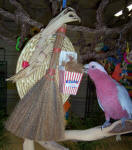 Sharing your life with companion
parrots is a serious responsibility which takes a great
deal of time and dedication. One of many challenges
faced is to provide your bird with an enriched
environment which includes but is not limited to being
safe, stimulating and entertaining too. Bird toys are
an important tool in helping meet these challenges.
Sharing your life with companion
parrots is a serious responsibility which takes a great
deal of time and dedication. One of many challenges
faced is to provide your bird with an enriched
environment which includes but is not limited to being
safe, stimulating and entertaining too. Bird toys are
an important tool in helping meet these challenges.
WOOD
Chewing is a natural instinct and essential to a bird’s
mental and physical well-being. If you provide only
"indestructible" toys (i.e., acrylics, bullet proof,
stainless steel) they will often find other, more
expensive ways to satisfy their chewing needs (i.e.,
molding, furniture). Consequently, wood is the perfect
choice for your toy making projects!
It is important to know what woods
are safe for your bird. Both soft and hardwoods are
commonly used in toys.
 SAFE
WOODS: (not a complete list)
SAFE
WOODS: (not a complete list)
Acacia, Alder, Almond, Apple, Arbutus, Ash, Aspen,
Bamboo, Beech, Birch, Bottle Brush, Citrus, Cork Oak,
Cottonwood, Crabapple, Dogwood, Elm, Eucalyptus, Fig
Species, Fir, Fruitless Mulberry, Ginkgo, Grape Vines,
Grape Palm, Guava, Hackberry, Hawthorn, Hazelnut,
Hibiscus, Hickory, Horse Apple (Bois d’arc), Ironwood,
Larch, Lilac, Liquidamber, Madrona, Magnolia, Manzanita,
Maple, Mediterranean Laurel, Mesquite (remove thorns),
Mimosa, Mulberry, Norfolk Island Pine, Nut (except
Chestnut & Oak), Palm, Papaya, Pear, Pecan, Pine,
Poplar, Ribbonwood, Rose, Sassafras, Spruce, Sweet Gum,
Sycamore, Thurlow, Tree fern, Umbrella tree, Vine Maple,
Walnut (NOT Black Walnut), Willow (Goat, Pussy &
Weeping).
UNSAFE WOODS: (not a
complete list)
Cedar, Hemlock, Plywood, Redwood, Sumac and NEVER use
pressure treated wood (it is treated with arsenic)!
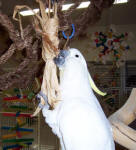 The internet is a fabulous resource
for researching safe woods, plants or just about
anything. If you have a question, you should be able to
find specifics on the web. To the best of my knowledge,
there is no ONE resource to give you a listing of what
is or is not safe for birds.
The internet is a fabulous resource
for researching safe woods, plants or just about
anything. If you have a question, you should be able to
find specifics on the web. To the best of my knowledge,
there is no ONE resource to give you a listing of what
is or is not safe for birds.
FORAGING
& NATURAL MATERIALS
When using natural branches or pine cones make sure they
have not been exposed to insecticides. Avoid collecting
branches from areas near highways or where there is a
greater likelihood of the plant life absorbing toxic
emissions from cars. You can clean branches with a
non-toxic disinfectant (diluted bleach solution of 4
parts water to 1 part bleach), rinse and dry thoroughly
(smaller items can be placed in warm oven 250 degrees
for 30 to 60 minutes).
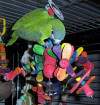 COLOR
COLOR
Birds are able to distinguish color so we believe that
color adds visual interest and hopefully will encourage
their interest. Busy Beaks, like many parrot toy
manufacturers, uses food coloring to dye their toys.
Never use fruit juices, Kool Aid™ or Jello™ since fruit
sugars can provide a perfect medium for bacterial
growth. We don’t add flavoring to wood … why encourage
"eating" something that’s not meant to be edible? Also,
do not buy toys that have been stained or varnished to
add color. If you are interested in a toy with painted
parts (i.e., ABC blocks) make sure that only non-toxic,
child safe paints were used.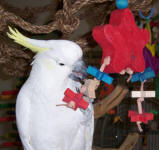
LEATHER
Leather is a great material for birds to safely play
with and chew on. Most birds especially like to spend
hours untying knots made in leather strips. Only
vegetable tanned leather should be used on bird toys.
DO NOT buy toys with dyed leather or leather tanned with
chemicals toxic to birds (i.e., chromium,
formaldehyde). This also means … do NOT recycle belts,
handbags, wallets, shoes, etc. to your birds toy box.
ROPE
Several kinds of rope are used in bird toys. Only 100%
natural fiber ropes such as abaca, cotton, hemp (jute),
or sisal should be used in bird toys. Nylon blend ropes
can result in serious injury and cuts due to the
strength of the strands if the birds get caught in it.
(Ropes can be safe as long as they are maintained
properly and the bird’s beak and nails are kept
trimmed.)
CHAIN
Chain should have welded not open links. Un-welded
chain provides sharp surfaces and narrow openings which
have been known to cut toes. Make sure the links are a
safe size for your bird, if toes get caught in the links
the result can be broken toes or legs. Check for
stainless steel or nickel plated materials (a quick tip,
stainless steel is NON magnetic so you can quickly
distinguish stainless from other metals using a common
magnet).
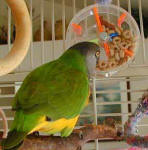 FASTENERS
FASTENERS
NEVER use key rings, notebook rings, split rings, spring
loaded links, shower hooks, or lanyard clips to connect
toys to a play stand or cage. Use appropriately sized
quick links (various sizes and shapes are readily
available) for your bird.
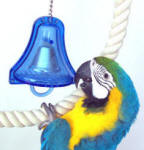 ACRYLICS
& PLASTICS
ACRYLICS
& PLASTICS
Acrylics are used in many toys today and if sized
properly to the bird are virtually indestructible.
There has been a shift back to wooden toys because
although acrylics are durable and attractive, they are
also not as fun for the bird who likes to chew. We
recommend that a few of your bird’s toys be acrylic or a
blend of acrylic and wood (refillable is even better),
they will be long lasting, and the bright colors used
are stimulating to your bird.
BELLS
If your bird loves bells but is mechanically inclined,
remove the clapper since the potential exists for
swallowing/choking. Do not buy toys with jingle bells
(toes can become caught and cut in the wide to narrow
openings); we recommend tube, cow or liberty bell
designs. The size of the bell should be able to
withstand the power of the beak.
GLUE
We prefer NOT to use glue, hot glue, adhesives,
permanent glue or wax on our toys. If you feel the need
to use glue, use only the water solution, white
non-toxic glue that is safe for children. There are
other safe options but always read labels for content.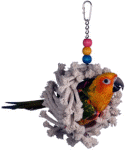
RINGS
& SWINGS
When choosing toys with rings or large plastic chain
links, make sure your bird can get his entire body
through the opening.
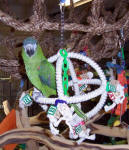 FINAL CONSIDERATIONS
FINAL CONSIDERATIONS
Just because the label says the product is safe doesn’t
mean that it’s OK for YOUR bird. Any toy has the
potential to be unsafe if improperly sized to the bird.
As with kids, no toy is 100% safe – one of our cockatoos
can turn a wooden block into a weapon! And some toys
should be placed OUTSIDE the cage where you can
supervise (like toys with batteries).
Provide a wide variety and rotate
them in and out of the cage or play area. One of my
favorite sayings is "Make the most of your real estate"
without over crowding them. Add components to a perch
(you can buy perches with toys attached too). Variety
will help alleviate boredom and keep your bird more
alert and curious. Just because a toy is designed to
be put inside the cage, doesn’t mean you can’t attach it
to the outside of the cage to expand their real estate!
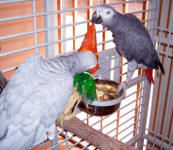 Foot
toys are a great way to introduce baby birds to toys!
We are big believers in foot toys. They are some of the
safest toys available and are perfect for birds (young
and old) to hone their coordination skills (see
Busy Beaks article on
foot toys).
Foot
toys are a great way to introduce baby birds to toys!
We are big believers in foot toys. They are some of the
safest toys available and are perfect for birds (young
and old) to hone their coordination skills (see
Busy Beaks article on
foot toys).
This is simply a guide. Every bird
has their own personality even in the same species and
household! So this list is by no means comprehensive.
When in doubt … err on the side of safety and remember,
you don’t have to be an expert on all birds … just your
own bird!
Remember, YOU are
responsible to check your parrot’s environment DAILY to
insure ropes are trimmed, links are tightened and items
are discarded BEFORE they become a hazard for your
parrot!
Busy Beaks ARE Happy Beaks™
Jan Graham
Copyright ©2005-2018


